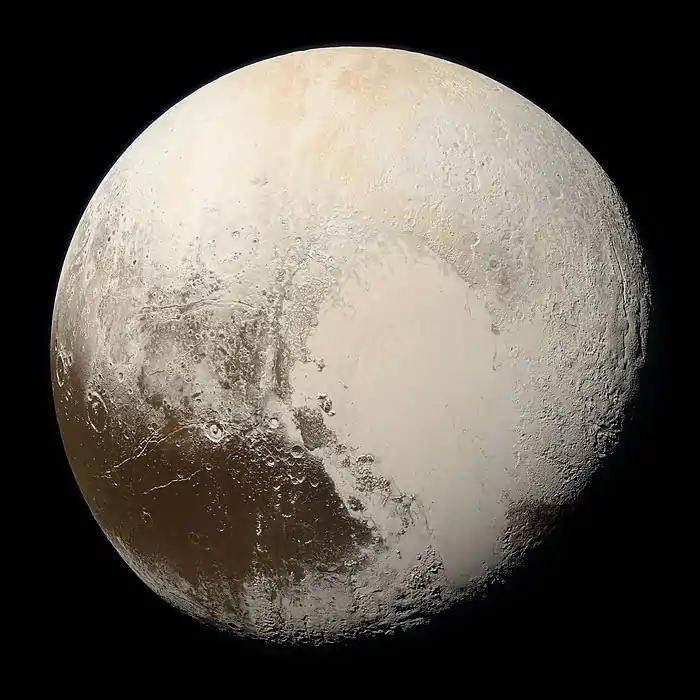(523692) 2014 EZ51
(523692) 2014 EZ51, provisional designation 2014 EZ51, is a trans-Neptunian object and possible dwarf planet in the scattered disc, approximately 600 kilometres (370 miles) in diameter. It was discovered on 18 April 2010, by the Pan-STARRS 1 survey at Haleakala Observatory, Hawaii, United States.[1]
| Discovery [1] | |
|---|---|
| Discovered by | Pan-STARRS 1 |
| Discovery site | Haleakala Obs. |
| Discovery date | 18 April 2010 |
| Designations | |
| (523692) 2014 EZ51 | |
| TNO [2] · SDO [3][4] p-DP [5] · distant [1] | |
| Orbital characteristics [2] | |
| Epoch 27 April 2019 (JD 2458600.5) | |
| Uncertainty parameter 3 | |
| Observation arc | 7.40 yr (2,704 d) |
| Aphelion | 64.418 AU |
| Perihelion | 40.631 AU |
| 52.525 AU | |
| Eccentricity | 0.2264 |
| 380.68 yr (139,042 d) | |
| 267.96° | |
| 0° 0m 9.36s / day | |
| Inclination | 10.257° |
| 27.522° | |
| 329.60° | |
| Physical characteristics | |
Mean diameter | >575 km (occultation)[6] 626 km (calculated)[5] |
| 0.11 (assumed)[5] | |
| 3.8[1][2] 4.2[5] | |
Orbit and classification
2014 EZ51 orbits the Sun at a distance of 40.6±64.4 AU once every 380 years and 8 months (139,042 days; semi-major axis of 52.53 AU). Its orbit has an eccentricity of 0.23 and an inclination of 10° with respect to the ecliptic.[2] The body's observation arc begins with its official discovery observation at Haleakala in April 2010.[1] According to Michael Brown it is a "highly likely" dwarf planet.[5]
Numbering and naming
This minor planet was numbered by the Minor Planet Center on 25 September 2018 (M.P.C. 111779).[7] As of 2018, it has not been named.[1]
Physical characteristics
According to astronomer Michael Brown, 2014 EZ51 measures 615 kilometres in diameter, based on an absolute magnitude of 4.2, with an assumed albedo of 0.10, respectively.[5] The Johnston's Archive claims a 770 km diameter, but does not state magnitude or albedo;[3] if it is assumed to use the 3.8 magnitude given by the MPC and JPL (themselves without albedo estimates)[1][2], this would correspond to an albedo of approx 0.092.
On 25 February 2019, a stellar occultation by 2014 EZ51 was observed in New Zealand. From these observations, a lower limit of 575 km was placed for its mean diameter.[6]
As of 2018, no physical characteristics have been determined from photometric observations. The body's rotation period, pole and shape remain unknown.[2][8][9]
References
- "523692 (2014 EZ51)". Minor Planet Center. Retrieved 9 October 2018.
- "JPL Small-Body Database Browser: 523692 (2014 EZ51)" (2017-09-12 last obs.). Jet Propulsion Laboratory. Retrieved 9 October 2018.
- "List of Known Trans-Neptunian Objects". Johnston's Archive. 22 July 2017. Retrieved 9 October 2018.
- "List Of Centaurs and Scattered-Disk Objects". Minor Planet Center. Retrieved 9 October 2018.
- Brown, Michael E. "How many dwarf planets are there in the outer solar system?". California Institute of Technology. Retrieved 13 August 2019.
- Loader, B.; Hanna, W. (25 February 2019). "(523692) 2014 EZ51, 2019 February 25 occultation". occultations.org.nz. Retrieved 5 January 2020.
- "MPC/MPO/MPS Archive". Minor Planet Center. Retrieved 9 October 2018.
- "LCDB Data for (523692)". Asteroid Lightcurve Database (LCDB). Retrieved 9 October 2018.
- "Asteroid (523692) 2014 EZ51". Small Bodies Data Ferret. Retrieved 9 October 2018.
External links
- Discovery Circumstances: Numbered Minor Planets (520001)-(525000) – Minor Planet Center
- (523692) 2014 EZ51 at AstDyS-2, Asteroids—Dynamic Site
- (523692) 2014 EZ51 at the JPL Small-Body Database

_(cropped).jpg.webp)



